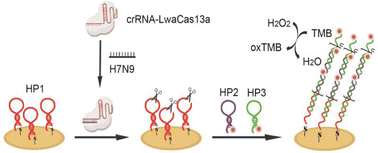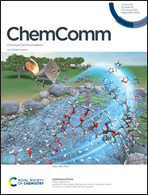CRISPR-empowered hybridization chain reaction amplification for an attomolar electrochemical sensor†
Abstract
Rapid pathogen screening holds the key against certain viral infections, especially in an overwhelming pandemic. Herein, a CRISPR-empowered electrochemical biosensor was designed for the ultrasensitive detection of the avian influenza A (H7N9) virus gene sequence. Combining the CRISPR/Cas system, a signal-amplification strategy and a high-conductivity sensing substrate, the developed biosensor showed an ultrawide dynamic range, an ultralow detection limit, and excellent selectivity for H7N9 detection, providing a potential sensing platform for the simple, fast, sensitive, and on-site detection of infectious diseases.



 Please wait while we load your content...
Please wait while we load your content...